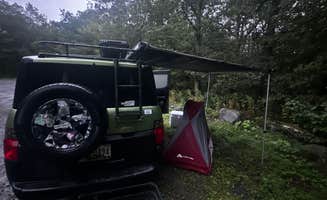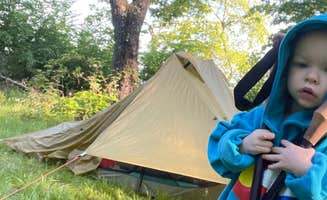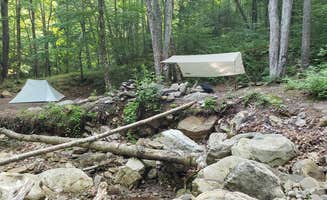Dispersed and primitive camping near Plymouth, Pennsylvania offers alternatives to established campgrounds for those seeking backcountry experiences. The region sits along the Appalachian Mountains with elevation changes from 400 to 1,600 feet in nearby areas. Winter camping requires additional preparation as temperatures frequently drop below freezing from November through March.
What to do
Hike interconnected trail systems: The Thunder Swamp Trailhead connects to extensive trail networks with marsh viewing opportunities. "Went down Saw Creek trail to a marsh," notes Jason R. The gravel parking area provides a convenient base for day hikes or overnight trips.
Backpacking excursions: Old Logger's Path supports weekend backpacking trips with established primitive sites along the route. "Great area. Beautiful views and nice Forrest," reports Mike D., who recommends it for one or two-night backpacking adventures.
View scenic overlooks: The Appalachian Trail Campsite area offers access to multiple ridge viewpoints characteristic of Pennsylvania's section of the AT. While the designated campsite itself has limited amenities, it serves as a strategic overnight point for hikers exploring the ridgeline views.
What campers like
Bear protection infrastructure: At Appalachian Trail- Designated Backpacker Campsite 2, Katharine T. notes "Well maintained w bear boxes provided," making food storage safer in bear country. This feature distinguishes this site from many other primitive camping areas.
Hammock camping opportunities: The terrain and tree cover at several sites specifically benefit hammock campers. Renee Z. shared that while one site was "a little on the small and sloped side for tent camping," it proved to be "a great place for hammocks" due to the appropriate tree spacing and maturity.
Solitude options: Primitive sites offer varying degrees of privacy. "There's plenty of space. We camped nearer to others but there are secluded spots too," explains Katharine T. about her experience at a designated backpacker campsite.
What you should know
Water source planning: Water availability is inconsistent across primitive camping areas. "There's no water nearby," warns Renee Z. about one site. Plan to either carry all water needed or research reliable water sources and bring purification methods.
Fire restrictions: Most primitive camping locations near Plymouth enforce no-fire policies year-round, especially along the Appalachian Trail corridor. Bring alternative cooking methods such as camp stoves.
Permit requirements: Several dispersed camping areas require permits obtained in advance. Thunder Swamp Trailhead is listed as requiring permits, so check with local authorities before overnight stays.
Tips for camping with families
Terrain considerations: When backpacking with less experienced family members, proper footwear becomes crucial. John S. noted after taking his wife on her first backpacking trip to Old Logger's Path: "She got to the end realizing that maybe she didn't pick the right boots (blisters) and her ankles were sore."
Pack weight distribution: For family trips, distribute weight according to age and ability. Heavier items should go to stronger hikers, while keeping everyone's pack weight proportional to their body weight.
Trail duration planning: For first-time backpackers, select shorter routes with bailout options. John S. successfully introduced his wife to backpacking despite some discomfort: "She said she loved it and would do it again," showing that even with challenges, family backcountry experiences can be positive.
Tips from RVers
Overnight trailhead parking: Several parking areas near primitive camping sites accommodate overnight stays in smaller vans or vehicles. Benjamin H. notes about Thunder Swamp Trailhead: "It's a gravel parking lot. Plenty of shade. No one bothered me."
Size limitations: Most primitive camping areas near Plymouth have parking areas unsuitable for larger RVs or trailers. Standard campervans and smaller vehicles work best at available trailhead parking areas.
Preparation for no hookups: All primitive camping locations lack water, electric, and sewer connections. Self-contained systems and adequate supply planning are essential for overnight vehicle stays.




